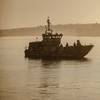Pollution Prevention Assignments
SMIT Salvage came to the rescue of Zhen Hua 010 when it grounded off of carrying five large ship-to-shore cranes. Ironically, this ship is featured prominently in another feature in this edition of MarineNews, coincidentally in Don Sutherland’s report of large crane deliveries to the .
SMIT Salvage has a role in removing threats to the marine environment. For example, during the second quarter work began on the recovery of oily residues from the wreck of the Haven. This VLCC went down off the Italian coast in the 1980s following an explosion and fire. There is no cargo oil remaining inside the wreck's tanks. The aim of this project, carried out under a contract from the Genoa Municipal Authority, was to remove residues from a total of 158 spaces, each of which has since been checked and certified free of oil. This project will protect the area's extensive oyster and mussel beds, together with tourist beaches, from contamination due to persistent leakage.
The Haven contract began in mid-April. It was completed in early June, to the full satisfaction of the client. This was a saturation diving assignment, with SMIT's divers working at depths of up to 75 m. The project spread included a barge with four-point moorings with SMIT Salvage owned saturation diving system and support tugs.
During the third quarter, SMIT is scheduled to begin another pollutant recovery. In this case the task is to remove 300 tons of IFO from the wreck of the Ice Prince. This general cargo vessel was lost in the when her timber cargo shifted. SMIT's contract is based on remote-operated recovery, using the "ROLS" — a system for hot-tapping tanks, with all functions controlled from the surface via ROVs.
The oil recovery contract was awarded by the owner's P&I Club. Work was expected to begin in late August, with the team expecting to spend around 30 days on-scene — depending on the weather. The project spread will include the use of a DP DSV.
Wreck Removal in Waters
Meanwhile, work continues on the removal of the stern section of the container vessel MSC Napoli, at a position just off the 's coast. This vessel was beached after sustaining serious damage during a violent storm in the during January of last year. SMIT Salvage removed 3,600 tons of HFO, together with all deck containers, and then discharged the holds. The vessel was refloated but the condition of her hull proved too weak for a safe tow. It was re-beached and work subsequently commenced on the basis of a wreck removal.
The MSC Napoli was separated into two sections last year. The bow was refloated and towed to for scrapping. The stern became the subject of this year's wreck removal operation.
Salvage Innovation
SMIT has a busy Salvage Innovation & Development Department, with a brief to focus on three principal areas: development of SMIT's environmental services, the evolution of new salvage equipment and techniques and, thirdly, "knowledge management" - the sharing and transmission of salvage expertise throughout the organization.
New equipment now in preparation includes a huge, 600 tons capacity debris grab. The HDW1 grab is an existing mechanical unit now modified for electronic/hydraulic operation.
This offers several advantages. The greater closing force delivers much increased grip. If required, the grab's jaws can bite into steel. The way in which the grab now operates also avoids a disadvantage associated with the mechanical variant, when use involved a loss of the sheerlegs' effective hoisting height.
Furthermore, the modified grab's control system provides improved monitoring and an enhanced ability to avoid damage. The electronic/hydraulic power packs have been designed for deepwater wreck clearance. They function at depths of up to 150 m.
(Reprinted from the September 2008 edition of MarineNews)












